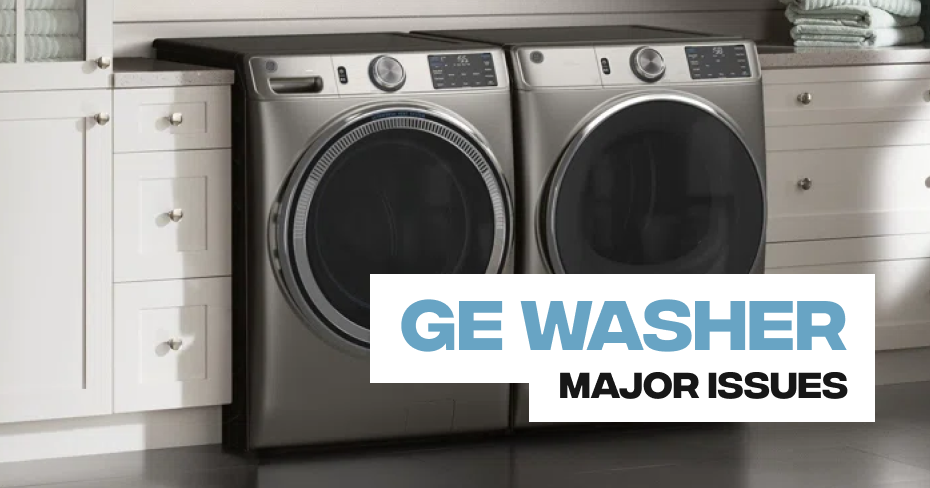
GE Washer Drainage Problems
A washer filled with soaking wet clothes and a puddle of water is not how a typical wash cycle should end. How do you fix a washing machine that won’t drain? First, check the drain hose for kinks or clogs that can block water flow. If the hose isn’t kinked, disconnect it to look for clogs that can prevent water from draining. Troubleshoot more common reasons for a GE washer not draining and how to solve the problem.
4 Common Reasons For A GE Washer Not Draining
A GE washer not draining has many potential causes, but there are usually several that are the most likely. We’ll detail how each can result in draining problems, pinpoint the right solution, and provide helpful tips to avoid future drainage issues.
#1. Kinked Or Clogged Drain Hose
A washer’s drain hose carries water out of the washing machine after it’s used. If the hose is kinked or clogged, water won’t be able to flow when the machine is draining. Locate the hose on the back of the machine and inspect it for kinks, gently straightening out the hose if necessary.
If there are no visible kinks, check the hose for clogs by disconnecting it from the drainpipe and placing it in an empty bucket. If water flows freely, there likely isn’t a clog. If the water flow is restricted, look inside the hose and remove any visible clogs. You may also have to disconnect the hose from the washer to reach the blockage. If the clog can’t be accessed, the hose needs to be replaced.
#2. Dirty Coin Trap Or Pump Filter
Many washers have a coin trap or pump filter that screens out debris before water is drained, preventing it from clogging the drain pump. If this trap or filter isn’t cleaned periodically, it can become clogged, resulting in a washing machine not draining completely.
Refer to your user manual to determine the location of your washer’s coin trap or pump filter. Most are located behind a small door on the front right corner of the machine. Open the door, and twist the filter to remove it. Dispose of any debris, rinse the filter, and wipe down the filter housing before replacing it and closing the door.
#3. Blocked Drain Pump
Even with a coin trap or pump filter, small articles of clothing or debris can reach the drain pump and create a blockage. When this happens, you’ll find your GE washer won’t drain just hums as the pump works to remove water unsuccessfully.
To inspect the pump for blockages, first check your user manual to determine how to access the drain pump on your model machine. If there are no visible obstructions but the pump still hums or operates loudly, it may require a professional replacement.
#4. Faulty Lid Switch
In top load washers, the lid switch is an electrical component that signals the washer when the lid is closed, enabling a wash cycle to start. If the lid isn’t closed or the switch is faulty, you’ll find your GE washer not draining or spinning after filling with water.
Multimeter testing of the switch can confirm that it’s faulty. If the switch has no continuity, it needs to be replaced.
Tips To Prevent Draining Problems
Many draining problems can be avoided with proper maintenance, use, and care.
Here’s how to prevent issues from a GE washer not draining:
- Check clothing pockets: When loading your machine, always check clothing pockets and remove any foreign objects that can cause a blockage.
- Clean washer regularly: Clean a washing machine on a monthly basis with a commercial tub cleaner or baking soda and vinegar. Wipe down the gasket on front load washers as well. This can prevent an accumulation of dirt and debris that can cause clogs.
- Empty coin trap or pump filter: When you clean the washer, empty the pump filter as well to remove any dirt or blockages.
- Always use HE detergent for HE machines: Using regular detergent in an HE washer creates excess suds, leaving behind a residue that can cause clogs.
